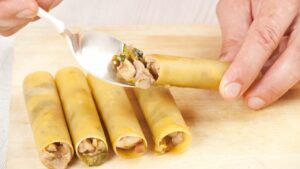Cooking stuffed pasta to perfection isn’t just about achieving that perfect al dente texture. It’s also about ensuring food safety by reaching the right internal temperature. But what exactly is this magic number that guarantees both delicious and safe-to-eat pasta?
What is The Minimum Internal Cooking Temperature for Stuffed Pasta

In light of recent emphasis on stuffed pasta’s appropriate internal temperature, a comprehension of safety protocols during cooking becomes indispensable. The key lies predominantly in understanding the minimum internal cooking temperatures. In the precise case of stuffed pasta, government food safety guidelines indicate a minimum internal temperature of 165°F (73°C). This figure emerges after rigorous scientific study considering various factors like bacteria survival, food texture, and taste preservation.
Knowledge of this exact temperature imparts a multitude of advantages. First, it assists in maintaining a vibrant palette of flavors. Second, it ensures the pasta cooks evenly throughout, enhancing the overall eating experience. Lastly, and crucially, cooking at this temperature eradicates harmful bacteria, preventing foodborne illnesses.
Under the umbrella of stuffed pasta, variations exist such as tortellini, ravioli, or manicotti. Despite the differences, the temperature rule remains consistent. Adjustments could be necessary while considering oven types and cooking times, but the internal temperature stays firm at 165°F (73°C).
Exploring the Risolid internal temperatures

Suitable internal cooking temperature remains a key factor in creating delicious and safe-to-eat stuffed pasta. For instance, Risolid, a popular type of stuffed pasta, demands the same careful attention. Maintaining an internal cooking temperature of 165°F (73°C) for Risolid isn’t merely a suggestion—it’s an FDA-recommended practice, thereby asserting its importance to both flavorful outcome and food safety. Risolid, like its tortellini and ravioli counterparts, might look different on the surface, but underneath, the same temperature rule applies. Remember, the core temperature of the pasta, not its surface or filling, provides the accurate measurement. Keeping the temperature consistent throughout cooking assures even doneness, obviates health hazards, and sustains the tasteful integrity of the dish. Inside the stuffed pasta’s world, the 165°F (73°C) temperature reigns supreme regardless of the variant, be it Risolid or any other type.
Recommendations for Cooking Stuffed Pasta
Ensuring Risolid or any stuffed pasta reaches the recommended 165°F (73°C) internal temperature calls for attention to certain cooking guidelines. First, use a food thermometer to accurately gauge the temperature. This tool’s importance is paramount, as it confirms the food’s interior has heated sufficiently to neutralize any harmful bacteria, primarily in pasta dishes that include meat or dairy fillings.
Next, allow the pasta to rest for three minutes post-cooking. This process, often overlooked or rushed, is fundamental as it contributes to heat equilibration, thus securing proper temperature throughout the dish. In addition to gauging the appropriate temperature and practicing patience, understanding your heat source is vital. Be aware of heat distribution and cooking times which vary between conventional and convection ovens.

Lastly, foster optimal conditions for heat transfer by avoiding overcrowded cooking trays. Giving each pasta piece its own space promotes even and efficient cooking. By adhering to these recommendations, you’re ensuring food safety while preserving the authentic flavor of your stuffed pasta dish.
Health Implications of Undercooked Stuffed Pasta
Cooking stuffed pasta, like tortellini and ravioli, to the correct internal temperature of 165°F (73°C) isn’t just about taste. It’s a crucial step for food safety. Risolid, for instance, needs to be maintained at this temperature throughout the cooking process. It’s not just about even doneness but also about eliminating health risks.
Using a food thermometer is a reliable way to ensure you’re hitting the right temperature. It’s also important to let the pasta rest after cooking and to understand your heat sources. Overcrowding your cooking trays can lead to inconsistent cooking, compromising food safety and the authentic flavor of your dish.
So, remember, the minimum internal cooking temperature for stuffed pasta isn’t just a suggestion—it’s a requirement for safe and delicious dining.

